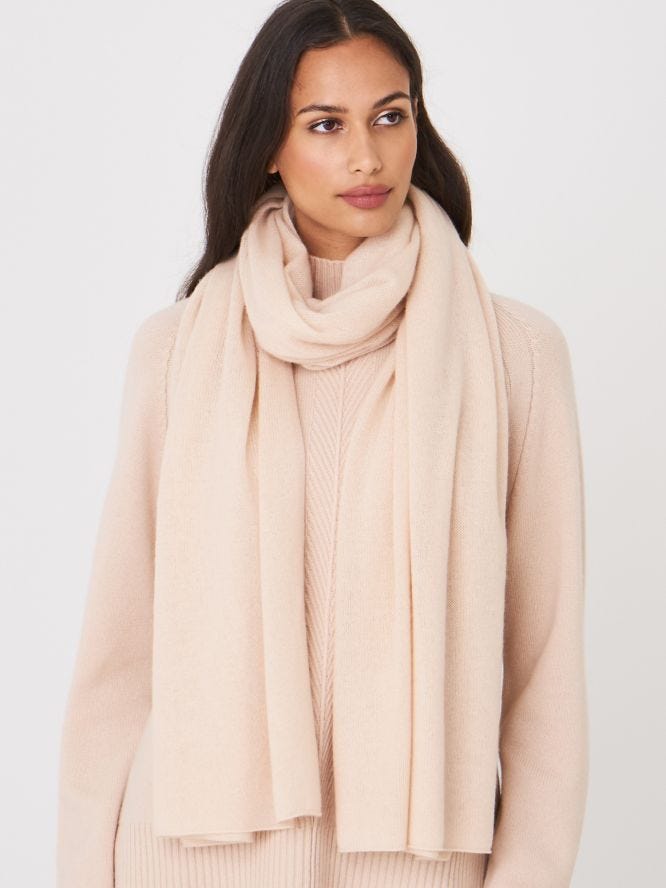History Of Scarf Fashion

How wonderful it is that nowadays many things are multifunctional and universal! After all, who doesn’t like it when you can “kill two birds with one stone” or simultaneously solve several problems at the same time.
Wrapping ourselves in a cashmere scarf in cool weather is not enough for us to just warm it up. Now there is an opportunity to pick up this accessory in any season to any wardrobe element that can protect from bad weather, and become an interesting highlight of the image, and hide something, and warm on a cold day. Who first came up with the idea of wrapping a long piece of material around the neck?
Incredibly, it turns out that this piece of clothing is quite ancient, its history begins almost two thousand years ago! Archaeological finds from the 70s of the XX century indicate that the ancient Chinese, or rather military personnel, began to wear a scarf for the first time. They tied a piece of material around their necks to protect them from cold and wind, that is, they used a scarf only for practical reasons.
Then, after several centuries, these pieces of fabric, wrapped around the neck, began to be used also as a designation of military rank: the warriors close to the emperor wore silk scarves, ordinary warriors wore cotton.
According to the same principle, as a sign of social status and authority, scarves were worn in Ancient Egypt and in the Roman Empire.
In the 17th century, silk or cashmere scarf became very popular among representatives of high society: Beethoven was inseparable with them, Napoleon Bonaparte himself adored scarves from India, and King Ludwig XIV of France, seeing for the first time bright silk scarves on Croatian soldiers, was in love with them with at first sight and created a special court office for the procurement and proper care of new Royal accessories. During this period, scarves began to perform an aesthetic function as well. One of the king's favorites came up with a way to tie a butterfly scarf.
During the period of hostilities in 1692, the steinkerk style was born, which consisted of the following: a scarf was wound around the neck, and the ends tied together in a knot were hidden in the collar of outerwear.
In the Russian open spaces, scarves appeared during the reign of Peter I at the end of the 17th century. They served as an accessory for military officers' uniforms. The officers' scarf was fitted with twisted thread tassels of silver or gold color and was made of fine silk, approximately 1.5 meters long. They were to be worn over the right shoulder, tying the tassels in a knot at the left thigh. By the way, Paul I, who later ascended the throne, extremely disliked scarves, as if anticipating their dark role in his fate: the emperor was strangled by one of the officers of the Russian army with this silk accessory.
And in 1783, in Krakow, a knitted scarf was invented. However, it became relevant only during the First World War, when scarves were one of the main winter men's accessories, especially for military pilots. Scarves were in demand among men in the 1920s and 1930s because of their military origins and their versatile ability to complement their everyday wardrobe. But the knitted cashmere scarf became trendy only in the 60s - 70s, in the wake of the fashion for knitwear.
In 1790, it became fashionable to wear over the neck, wrapped several times, large size starched shawls made of muslin fabric. The French called them the funny word "encruyable", which translates as "incredible" and opened special private lessons in Paris teaching the difficult craft of tying and wearing such scarves. And in the middle of the 19th century, young French revolutionaries began to wear woolen mufflers - a scarf that shelters not only the neck, but also the lower part of the face from the cold and chill. At first, they were of dull colors and in a cage, and later they began to be sewn from thin and bright colored silk fabrics with patterns.
In Russia, during this period, there was a decline in interest in this accessory, since it was a symbol of rebellion and denial of the regime. Therefore, mufflers were chosen by criminal groups and wore them to emphasize their belonging to any group. It was only at the end of the 19th century that women began to wear comforters made of wool in a cage in cool weather. For a long time in Soviet Russia, a scarf was considered only an accessory for women and children.
The end of the 19th century gave rise to the popularity and demand for scarves as a practical and beautiful accessory. Fashion houses got down to business, creating personalized models of scarves and shawls, among which the French house Hermès became the leader. His silk scarves - squares became a cult and entered the history of fashion. Silk remained the most popular material, and patterns and prints were striking in their variety. Queen Victoria of Great Britain played an important role in increasing the demand for scarves, as the scarf became her favorite accessory and a permanent element of her royal wardrobe. At the same time, there was a way to tie a scarf called "four-in-hand". This knot is used by men to tie a cashmere scarf or tie to this day. A little later, thanks to Burberry, plaid fabric came into fashion and scarves began to be sewn from it.
At the beginning of the 21st century, the scarf began to triumphant in descent to the heights of fashion. Designers have breathed new meaning into this accessory: a scarf can be not only practical, but also play the role of a fashion accessory, as well as adjust the image.
There are a great many varieties of scarves: they can be winter: , demi-season or summer. Each person can have several types of scarves in his wardrobe, it can be a shawl, stole, snood, poncho, arafatka, a scarf-skate or a collar, a good old boa, etc. As you can see, the choice is rich! The fashion for fabrics has also changed, all sorts of options can be used to create scarves: from delicate silk to coarse raw silk, but natural fabrics remain more in demand: linen, cotton, cashmere, corrugation, wool, as well as a combination of fabrics.
The imagination and the decor of the scarves are striking, since all sorts of elements are also used here in the form of fringes, pompons, beads, fur, leather, embroidery, etc. Of course, this mainly applies to female models. Colors and prints change with each season, adjusting to fashionable modern trends. There are such beautiful models that it is precisely for such a luxurious accessory that an outfit is selected, and not vice versa. What also makes a scarf the most attractive and versatile accessory is the variety of options for tying and wearing it. You can find more than 20 ways to tie women's scarves around the neck and about 10 options for men. It can be worn not only around the neck, but also on the hips or tied around the head.
Over the centuries, the cashmere scarf has evolved and brought together its core functions. However, there are scarves that continue to carry a distinctive role. For example, nowadays you can find many scarves with certain logos, which mean belonging to a particular community. For example, in any sports fan club, the fan scarf is a key piece of merchandise that shows loyalty to your team. Football fans, regardless of age or social status, must wear this accessory when going to a football match or club meeting. For the first time, the fan scarf appeared in the 60s in England, where, in fact, football was born as a sport. They were made of thick woolen fabric with stripes, made in the colors of the club. Soon they began to appear in the stadiums of Italy.
Sometimes fans' scarves were called “rosettes” or “roses”: roofing felts in honor of the ribbon that fans in Europe hung on their chests long before scarves came into fashion, or because the knotted scarf resembles a rose flower.
In the USSR, they began to appear in the 80s: at first they tried to make “rosettes” from ordinary cotton fabric, on which a colorful pattern was applied. However, this option turned out to be impractical and short-lived. Then they began to knit: by themselves, who knew how, or to order. The first such long knitted scarves were wrapped around the fans of the Moscow "Spartak", and in the 80s this accessory was also acquired by the fans of the St. Petersburg "Zenith".
By the mid-90s, fans began to wear scarves along with fans. Thanks to new technologies, new scarves began to be produced, from which even the smallest details were knitted. Now, in terms of variety, fan scarves are not far behind the usual ones.
There are fan scarves: title scarves, sponsor scarves or double scarves for matches in Euro cups, anti-club scarves (dedicated to “love” for another club), etc. Each club has its own rules and design features for a fan scarf. They are kept as a keepsake and collected. So the fashion for scarves, especially knitted ones, did not pass by the football life.
Now everyone has the opportunity not only to choose a practical and beautiful cashmere scarf for every day, but also to order for themselves an exclusive scarf with any inscription to visit the stadium.

History Of Scarf Fashion
- The history of the origin and development of silks, wool and cashmere carves fashion in Europe.

How Britain Became the Dumbest Society in the World free f54
- It is a harsh truth that most people don’t like to hear: when it comes to relationships, the saying “don’t judge a book

Islamic Method - Visually Tempting and Uplifting
- what your location is contemplating using your certification study course, to learn. They will surely know the requirements and be able to give you

Green Ammonia Market Trends, Growth Factor and Foreseen till 2027
- Global Green Ammonia Market was valued at US$ 11.5 Million in 2020 and is anticipated to reach US$ 215 Million by 2027 displaying an elevated CAGR